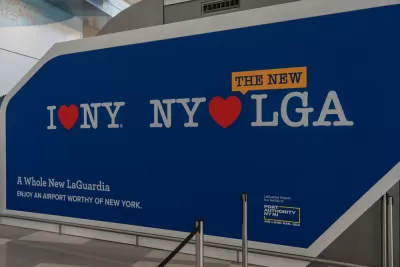After an $8 billion renovation, critics of the much-maligned airport claim the design is disjointed, while public transit access to the new terminals remains minimal.

In a piece for Bloomberg CityLab, James S. Russell describes the $8 billion renovation of “America’s most reviled airport,” New York’s LaGuardia.
Despite the massive investment in the modernization of the new terminals, the airport is, as Russell writes, “trapped in the husk of its reviled predecessor.” This is because “the ‘new’ LaGuardia’s expansion was constrained on a site that opened to pontooned flying boats and DC-3s in 1939. From the air, it looks like taffy pulled in several directions. Recently constructed buildings and roads had to dodge and weave among the detritus of boneheaded decisions past, including bits of the older terminals that had to remain in service as new ones were constructed.”
According to Russell, “Coherence and passenger-calming clarity in wayfinding have always been held sacrosanct by airport designers. But the new Terminal B — while a vast improvement that has been greeted with praise and was awarded the 2021 Prix Versailles, UNESCO’s annual architecture prize — is among the most idiosyncratic that air travelers are likely to encounter.” However, “Despite its busyness, the Terminal B pleases with its detailed focus on its users, from the new, roomier bathrooms to the unintimidating security checkpoint.” Russell goes on to describe Terminal C, designed by and for Delta to maximize efficiency and ease of experience for travelers.
The refreshed airport comes with another caveat: “Access to the airport is likely to continue to induce havoc, since there’s a lingering lack of roadway and parking capacity.” The airport continues to lack good access to public transit, and “ride-hailing services are accommodated as an afterthought.”
FULL STORY: The New LaGuardia Is Haunted by the Mistakes of its Past

Planetizen Federal Action Tracker
A weekly monitor of how Trump’s orders and actions are impacting planners and planning in America.

Congressman Proposes Bill to Rename DC Metro “Trump Train”
The Make Autorail Great Again Act would withhold federal funding to the system until the Washington Metropolitan Area Transit Authority (WMATA), rebrands as the Washington Metropolitan Authority for Greater Access (WMAGA).

DARTSpace Platform Streamlines Dallas TOD Application Process
The Dallas transit agency hopes a shorter permitting timeline will boost transit-oriented development around rail stations.

Renters Now Outnumber Homeowners in Over 200 US Suburbs
High housing costs in city centers and the new-found flexibility offered by remote work are pushing more renters to suburban areas.

The Tiny, Adorable $7,000 Car Turning Japan Onto EVs
The single seat Mibot charges from a regular plug as quickly as an iPad, and is about half the price of an average EV.

Supreme Court Ruling in Pipeline Case Guts Federal Environmental Law
The decision limits the scope of a federal law that mandates extensive environmental impact reviews of energy, infrastructure, and transportation projects.
Urban Design for Planners 1: Software Tools
This six-course series explores essential urban design concepts using open source software and equips planners with the tools they need to participate fully in the urban design process.
Planning for Universal Design
Learn the tools for implementing Universal Design in planning regulations.
Municipality of Princeton
Roanoke Valley-Alleghany Regional Commission
City of Mt Shasta
City of Camden Redevelopment Agency
City of Astoria
Transportation Research & Education Center (TREC) at Portland State University
US High Speed Rail Association
City of Camden Redevelopment Agency
Municipality of Princeton (NJ)



























